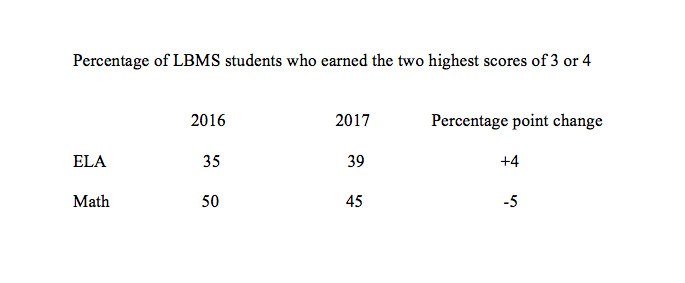State ELA, math scores released
Officials: results are inconclusive due to high opt-out rates
The New York State Education Department released the results of this spring’s Common Core exams last month, showing improved scores for Long Beach Middle School students who took English Language Arts tests and declining scores for those who took mathematics exams.
School officials argue, however, that the results are inconclusive because of the high number of students who did not sit for the tests as part of the growing opt-out movement, which began after the standards were implemented in New York schools in 2012.
This year, almost half of eligible Long Beach students in grades three through eight refused to take the ELA exams. A total of 717 out of 1,565 enrolled students sat out the tests — 45.8 percent of the testable population.
In the spring, 39 percent of Long Beach Middle School students who took the ELA exam scored at the two highest levels, 3 or 4 — up from 34 percent in 2016. A total of 355 students took the exam, 27 fewer than the prior year, according to the state.
Additionally, 45 percent of students who took the mathematics exam scored at the two highest levels, 5 percentage points fewer than in 2016. Despite the decrease, 12 more students — a total of 284 — took the exam this spring than in 2016.
The middle school’s results are comparable to the county’s and state’s overall. In Nassau County, 53 percent of students in grades three through eight scored 3 or 4 on the ELA exam, 2 percentage points higher than in 2016. Fifty-six percent did so on the math exams, 1 percentage point higher than in 2016.
About 38 percent of students statewide scored at the two highest levels on the ELA exam in 2016, while about 40 percent did so this spring. About 39 percent of students statewide scored 3 or 4 on the math exam in 2016, while about 40 percent did so this spring.
“The news is generally positive, and shows steady progress in many areas,” State Education Commissioner MaryEllen Elia said in a statement about the exams, which were renamed the Next Generation Learning Standards in May. “…That’s good news. And our teachers, parents and students should be proud that their hard work is paying off.”
Nonetheless, Schools Superintendent David Weiss said, “With an opt-out rate as high as ours, and equally high in other districts, it is impossible to draw any conclusions of any kind. You can only draw conclusions from valid numbers. These numbers are not useable in any comparative way.”
Statewide, the test-refusal rate last school year was about 19 percent, a decline of 2 percentage points from the prior year.
Matt Adler, a Seaford High School math teacher who has kept his son out of the tests for the past two years, said the results are not comparable to those of previous years. “I put no weight in those numbers, because they’re meaningless,” he said. “What is defined as proficient? The gauge to get a [score of] 3 each year changes. It’s a moving target. How can you compare from one year to the next when that target keeps getting moved each year? That’s not relevant data.”
Adler also criticized a lack of progress in improving the tests on the state level. “The state keeps churning out the numbers, saying things have changed, but what has changed?” he said. “It’s the same issues: These tests and questions are age-inappropriate. … They’re asking people to put faith in the state [to make] valid exams, but every time they do, there are more issues.”
Kemala Karmen, a Brooklyn public school parent and a founding member of NYC Opt Out — a coalition of parents who boycott state tests each year — also said that the scores are not comparable to previous ones. “Progress on standardized tests can only be measured if the testing instrument, conditions and manner of scoring remain consistent from year to year,” Karmen said in a statement. “This is not the case.”
After receiving feedback from parents and teachers, the state announced this year that it would reduce the number of test days from three to two beginning next spring. In 2015, the state placed a four-year moratorium on using test scores to evaluate teachers. But many say that more reform is needed.
Despite criticizing the state for releasing what he called inconclusive exam results, Weiss added a message of encouragement. “Each score does, however, have meaning on its own,” he said, “for the test-taker, his or her teacher and parent in identifying individual strengths and weaknesses.”







